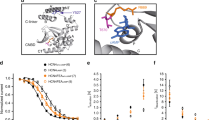Abstract
CYCLIC AMP and cyclic GMP have been suggested to play opposing regulatory roles in several biological systems1. Supporting evidence for the yin yang hypothesis of opposing biological regulation has been obtained in sympathetic ganglia2,3 and pyramidal neurones in the rat cerebral cortex4. In the mammalian heart, the role of cyclic AMP in mediating the positive inotropic response to catecholamines was advanced by the observation that the inotropic effect was preceded by an increase in cyclic AMP levels5. On the other hand, the levels of cyclic GMP were found to be increased after cholinergic stimulation6. In frog, oscillations of cyclic AMP7 and cyclic changes in the levels of cyclic AMP and cyclic GMP8 during the cardiac cycle have been reported. The importance of cyclic AMP for the inotropic effects of catecholamines was confirmed by the observation that the dibutyryl derivative of cyclic AMP exerted a positive inotropic effect in cat papillary muscles9 and in the isolated perfused hearts from rabbits, rats and guinea pigs10. I now report a direct negative inotropic effect of 8-Br-cyclic GMP on force of contraction (Fc) in rat auricles and papillary muscles from cats.
This is a preview of subscription content, access via your institution
Access options
Subscribe to this journal
Receive 51 print issues and online access
$199.00 per year
only $3.90 per issue
Buy this article
- Purchase on Springer Link
- Instant access to full article PDF
Prices may be subject to local taxes which are calculated during checkout
Similar content being viewed by others
References
Goldberg, N. D., Haddox, M. K., Hartle, D. K., and Hadden, J. W., Proc. Fifth Int. Congr. Pharmac. (edit by Maxwell, R. A., and Acheson, G. H.), 146–149 (Karger, Basel, 1973).
McAfee, D. A., and Greengard, P., Science, 178, 310–312 (1972).
Kebabian, J. W., Steiner, A. L., and Greengard, P., J. Pharmac. exp. Ther., 193, 474–488 (1975).
Stone, T. W., Taylor, D. A., and Bloom, F. E., Science, 187, 845–847 (1975).
Cheung, W. Y., and Williamson, J. R., Nature, 207, 979–981 (1965).
George, W. J., Polson, J. B., O'Toole, A. G., and Goldberg, N. D., Proc. natn. Acad. Sci. U.S.A., 66, 398–403 (1970).
Brooker, G., Science, 182, 933–934 (1973).
Wollenberger, A., et al., Biochem. biophys. Res. Commun., 55, 446–452 (1973).
Skelton, C. L., Levey, G. S., and Epstein, S. E., Circulation Res., 26, 35–43 (1970).
Kukovetz, W. R., and Pöch, G., Naunyn-Schmiedebergs Arch. Pharmak., 266, 236–254 (1970).
Meinertz, T., Nawrath, H., and Scholz, H., Pflügers Arch. ges. Physiol., 333, 197–212 (1972).
Meinertz, T., Nawrath, H., and Scholz, H., Naunyn-Schmiedeberg's Arch. Pharmac., 278, 165–178 (1973).
TenEick, R. E., Nawrath, H., McDonald, T. F., and Trautwein, W., Pflugers Arch. ges. Physiol., 361, 207–213 (1976).
Schneider, J. A., Brooker, G., and Sperelakis, N., J. molec. cell. Cardiol., 7, 867–876 (1975).
Cubeddu, L. X., Barnes, E., and Weiner, N., J. Pharmac. exp. Ther., 191, 444–457 (1974).
Author information
Authors and Affiliations
Rights and permissions
About this article
Cite this article
NAWRATH, H. Cyclic AMP and cyclic GMP may play opposing roles in influencing force of contraction in mammalian myocardium. Nature 262, 509–511 (1976). https://doi.org/10.1038/262509b0
Received:
Accepted:
Issue Date:
DOI: https://doi.org/10.1038/262509b0
This article is cited by
-
Cyclic GMP‐dependent protein kinase activation in the absence of negative inotropic effects in the rat ventricle
British Journal of Pharmacology (1997)
-
Kardiale Wirkungen von Adenosin
Klinische Wochenschrift (1987)
-
Effects of papaverine on calcium efflux and contractility in superfused rat left atria
Naunyn-Schmiedeberg's Archives of Pharmacology (1986)
-
Hemodynamic effects of dibutyryl cyclic GMP in anesthetized dogs
Basic Research in Cardiology (1986)
-
Adenosine activates a potassium conductance in guinea-pig atrial heart muscle
Experientia (1983)
Comments
By submitting a comment you agree to abide by our Terms and Community Guidelines. If you find something abusive or that does not comply with our terms or guidelines please flag it as inappropriate.



